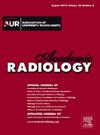Non-invasive Prediction of Lymph Node Metastasis in NSCLC Using Clinical, Radiomics, and Deep Learning Features From 18F-FDG PET/CT Based on Interpretable Machine Learning
IF 3.8
2区 医学
Q1 RADIOLOGY, NUCLEAR MEDICINE & MEDICAL IMAGING
引用次数: 0
Abstract
Purpose
This study aimed to develop and evaluate a machine learning model combining clinical, radiomics, and deep learning features derived from PET/CT imaging to predict lymph node metastasis (LNM) in patients with non-small cell lung cancer (NSCLC). The model's interpretability was enhanced using Shapley additive explanations (SHAP).
Methods
A total of 248 NSCLC patients who underwent preoperative PET/CT scans were included and divided into training, test, and external validation sets. Radiomics features were extracted from segmented tumor regions on PET/CT images, and deep learning features were generated using the ResNet50 architecture. Feature selection was performed using minimum-redundancy maximum-relevance (mRMR), and the least absolute shrinkage and selection operator (LASSO) algorithm. Four models—clinical, radiomics, deep learning radiomics (DL_radiomics), and combined model—were constructed using the XGBoost algorithm and evaluated based on diagnostic performance metrics, including area under the receiver operating characteristic curve (AUC), accuracy, F1 score, sensitivity, and specificity. Shapley Additive exPlanations (SHAP) was used for model interpretability.
Results
The combined model achieved the highest AUC in the test set (AUC = 0.853), outperforming the clinical (AUC = 0.758), radiomics (AUC = 0.831), and DL_radiomics (AUC = 0.834) models. Decision curve analysis (DCA) demonstrated that the combined model offered greater clinical net benefits. SHAP was used for global interpretation, and the summary plot indicated that the features ct_original_glrlm_LongRunHighGrayLevelEmphasis, and pet_gradient_glcm_lmc1 were the most important for the model’s predictions.
Conclusion
The combined model, combining clinical, radiomics, and deep learning features from PET/CT, significantly improved the accuracy of LNM prediction in NSCLC patients. SHAP-based interpretability provided valuable insights into the model's decision-making process, enhancing its potential clinical application for preoperative decision-making in NSCLC.
基于可解释性机器学习的18F-FDG PET/CT临床、放射组学和深度学习特征无创预测NSCLC淋巴结转移
目的:本研究旨在开发和评估一种结合临床、放射组学和PET/CT成像的深度学习特征的机器学习模型,以预测非小细胞肺癌(NSCLC)患者的淋巴结转移(LNM)。采用Shapley加性解释(SHAP)增强了模型的可解释性。方法:共纳入248例接受术前PET/CT扫描的NSCLC患者,分为训练组、测试组和外部验证组。从PET/CT图像上分割的肿瘤区域提取放射组学特征,并使用ResNet50架构生成深度学习特征。使用最小冗余最大相关性(mRMR)和最小绝对收缩和选择算子(LASSO)算法进行特征选择。使用XGBoost算法构建临床、放射组学、深度学习放射组学(DL_radiomics)和联合模型四种模型,并根据诊断性能指标进行评估,包括受试者工作特征曲线下面积(AUC)、准确性、F1评分、敏感性和特异性。模型可解释性采用Shapley加性解释(SHAP)。结果:联合模型在测试集中的AUC最高(AUC=0.853),优于临床模型(AUC=0.758)、放射组学模型(AUC=0.831)和DL_radiomics模型(AUC=0.834)。决策曲线分析(DCA)表明,联合模型提供了更大的临床净效益。使用SHAP进行全局解释,总结图显示,ct_original_glrlm_LongRunHighGrayLevelEmphasis和pet_gradient_glcm_lmc1特征对模型的预测最重要。结论:该联合模型结合临床、放射组学和PET/CT的深度学习特征,显著提高了NSCLC患者LNM预测的准确性。基于shap的可解释性为模型决策过程提供了有价值的见解,增强了其在非小细胞肺癌术前决策中的潜在临床应用。
本文章由计算机程序翻译,如有差异,请以英文原文为准。
求助全文
约1分钟内获得全文
求助全文
来源期刊

Academic Radiology
医学-核医学
CiteScore
7.60
自引率
10.40%
发文量
432
审稿时长
18 days
期刊介绍:
Academic Radiology publishes original reports of clinical and laboratory investigations in diagnostic imaging, the diagnostic use of radioactive isotopes, computed tomography, positron emission tomography, magnetic resonance imaging, ultrasound, digital subtraction angiography, image-guided interventions and related techniques. It also includes brief technical reports describing original observations, techniques, and instrumental developments; state-of-the-art reports on clinical issues, new technology and other topics of current medical importance; meta-analyses; scientific studies and opinions on radiologic education; and letters to the Editor.
 求助内容:
求助内容: 应助结果提醒方式:
应助结果提醒方式:


